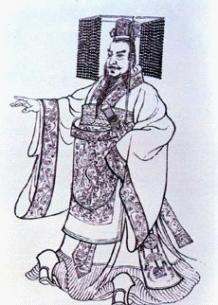hdu4081Qin Shi Huang's National Road System【次小生成树】
来源:互联网 发布:博客数据出售 编辑:程序博客网 时间:2024/06/05 09:55
Qin Shi Huang's National Road System
Time Limit: 2000/1000 MS (Java/Others) Memory Limit: 32768/32768 K (Java/Others)Total Submission(s): 5982 Accepted Submission(s): 2084
Problem Description
During the Warring States Period of ancient China(476 BC to 221 BC), there were seven kingdoms in China ---- they were Qi, Chu, Yan, Han, Zhao, Wei and Qin. Ying Zheng was the king of the kingdom Qin. Through 9 years of wars, he finally conquered all six other kingdoms and became the first emperor of a unified China in 221 BC. That was Qin dynasty ---- the first imperial dynasty of China(not to be confused with the Qing Dynasty, the last dynasty of China). So Ying Zheng named himself "Qin Shi Huang" because "Shi Huang" means "the first emperor" in Chinese.

Qin Shi Huang undertook gigantic projects, including the first version of the Great Wall of China, the now famous city-sized mausoleum guarded by a life-sized Terracotta Army, and a massive national road system. There is a story about the road system:
There were n cities in China and Qin Shi Huang wanted them all be connected by n-1 roads, in order that he could go to every city from the capital city Xianyang.
Although Qin Shi Huang was a tyrant, he wanted the total length of all roads to be minimum,so that the road system may not cost too many people's life. A daoshi (some kind of monk) named Xu Fu told Qin Shi Huang that he could build a road by magic and that magic road would cost no money and no labor. But Xu Fu could only build ONE magic road for Qin Shi Huang. So Qin Shi Huang had to decide where to build the magic road. Qin Shi Huang wanted the total length of all none magic roads to be as small as possible, but Xu Fu wanted the magic road to benefit as many people as possible ---- So Qin Shi Huang decided that the value of A/B (the ratio of A to B) must be the maximum, which A is the total population of the two cites connected by the magic road, and B is the total length of none magic roads.
Would you help Qin Shi Huang?
A city can be considered as a point, and a road can be considered as a line segment connecting two points.

Qin Shi Huang undertook gigantic projects, including the first version of the Great Wall of China, the now famous city-sized mausoleum guarded by a life-sized Terracotta Army, and a massive national road system. There is a story about the road system:
There were n cities in China and Qin Shi Huang wanted them all be connected by n-1 roads, in order that he could go to every city from the capital city Xianyang.
Although Qin Shi Huang was a tyrant, he wanted the total length of all roads to be minimum,so that the road system may not cost too many people's life. A daoshi (some kind of monk) named Xu Fu told Qin Shi Huang that he could build a road by magic and that magic road would cost no money and no labor. But Xu Fu could only build ONE magic road for Qin Shi Huang. So Qin Shi Huang had to decide where to build the magic road. Qin Shi Huang wanted the total length of all none magic roads to be as small as possible, but Xu Fu wanted the magic road to benefit as many people as possible ---- So Qin Shi Huang decided that the value of A/B (the ratio of A to B) must be the maximum, which A is the total population of the two cites connected by the magic road, and B is the total length of none magic roads.
Would you help Qin Shi Huang?
A city can be considered as a point, and a road can be considered as a line segment connecting two points.
Input
The first line contains an integer t meaning that there are t test cases(t <= 10).
For each test case:
The first line is an integer n meaning that there are n cities(2 < n <= 1000).
Then n lines follow. Each line contains three integers X, Y and P ( 0 <= X, Y <= 1000, 0 < P < 100000). (X, Y) is the coordinate of a city and P is the population of that city.
It is guaranteed that each city has a distinct location.
For each test case:
The first line is an integer n meaning that there are n cities(2 < n <= 1000).
Then n lines follow. Each line contains three integers X, Y and P ( 0 <= X, Y <= 1000, 0 < P < 100000). (X, Y) is the coordinate of a city and P is the population of that city.
It is guaranteed that each city has a distinct location.
Output
For each test case, print a line indicating the above mentioned maximum ratio A/B. The result should be rounded to 2 digits after decimal point.
Sample Input
241 1 201 2 30200 2 80200 1 10031 1 201 2 302 2 40
Sample Output
65.0070.00
Source
2011 Asia Beijing Regional Contest
今天捡起来好久没碰的图——次小生成树,不难的一个知识点,貌似考的也不多,百度首页除了裸的题就是这个了。
说题意:秦始皇统一中国之后要在全国修公路连接各个城市,抠门皇帝只想修成最小生成树(距离最小,不考虑人力),一个道士说自己可以不花人力物力修一条路,经过两方妥协,选择max(两个城市人口/生成树长度-这条路的长度)的路让他变,求这个比值最大值。
先说说次小生成树的形成过程,在prim最小生成树的算法基础上,记录每两个点之间路径上最长的边长,如果要求次小生成树的数值的话,遍历每一条不在最小生成树中的边,用来替换一条这两个点在最小生成树上那条路径的最长的边,记录当前生成树的总长度,遍历一圈找最小的。
这个题没问次小生成树的值,但是用到了路径最长边这个数组,我叫他Max[][],题中问的是(两个城市人口/生成树长度-这条路的长度),我们首先考虑分母最小,因为对于某个边来说分子是定值啊,分母分成两种情况:1.这个边是最小生成树上的,那啥也别说,mst-cost[][]即可 2.这条边不在最小生成树上:那就是含有这个边的某个生成树,(这么说来这个题应该归纳到次小生成树啊==),mst-Max+cost即可
/*************hdu40812016.2.2993MS18492K2345 BC++*************/#include <iostream>#include<cstdio>#include<cstring>#include<cmath>using namespace std;const int maxn=1010;const int inf=0x3f3f3f3f;bool vis[maxn],used[maxn][maxn];double lowc[maxn];int pre[maxn];double Max[maxn][maxn],cost[maxn][maxn];struct node{ int x,y,pop;}num[1010];double min(double a,double b){if(a<b) return a;return b;}double max(double a,double b){if(a>b) return a;return b;}inline double Dist(node v1,node v2){ return sqrt(double(v1.x-v2.x)*(v1.x-v2.x)+double(v1.y-v2.y)*(v1.y-v2.y));}double prim(int n){ double ans=0; memset(vis,false,sizeof(vis)); memset(Max,0,sizeof(Max)); memset(used,false,sizeof(used)); vis[0]=true; pre[0]=-1; for(int i=0;i<n;i++) { lowc[i]=cost[0][i]; pre[i]=0; } // lowc[0]=0.0; for(int i=1;i<n;i++) { double minc=1.0*inf; int p=-1; for(int j=0;j<n;j++) if(!vis[j]&&(minc>lowc[j]||p==-1)) { minc=lowc[j]; p=j; } ans+=minc; vis[p]=true; used[p][pre[p]]=used[pre[p]][p]=true; for(int j=0;j<n;j++) { if(vis[j]&&j!=p)//j!=p必须加!!1 Max[j][p]=Max[p][j]=max(Max[j][pre[p]],lowc[p]); if(!vis[j]&&lowc[j]>cost[p][j]) { lowc[j]=cost[p][j]; pre[j]=p; } } } return ans;}int main(){ //freopen("cin.txt","r",stdin); int t,n; scanf("%d",&t); while(t--) { scanf("%d",&n); for(int i=0;i<n;i++) scanf("%d%d%d",&num[i].x,&num[i].y,&num[i].pop); for(int i=0;i<n;i++) for(int j=i+1;j<n;j++) cost[i][j]=cost[j][i]=Dist(num[i],num[j]); double mst=prim(n); // double mst=smst(n,ans); double ans=-1; for(int i=0;i<n;i++) for(int j=i+1;j<n;j++) { if(used[i][j])//on mst ans=max(ans,1.0*(num[i].pop+num[j].pop)/(mst-cost[i][j])); else ans=max(ans,1.0*(num[i].pop+num[j].pop)/(mst-Max[i][j])); } printf("%.2f\n",ans); } return 0;} 0 0
- hdu4081Qin Shi Huang's National Road System(次小生成树)
- hdu4081Qin Shi Huang's National Road System 次小生成树
- hdu4081Qin Shi Huang's National Road System【次小生成树】
- hdu4081Qin Shi Huang's National Road System(次小生成树)
- hdu4081Qin Shi Huang's National Road System
- HDU4081Qin Shi Huang's National Road System(最小生成树+DFS)
- HDU 4081 Qin Shi Huang's National Road System (次小生成树算法)
- hdu 4081 Qin Shi Huang's National Road System(次小生成树)
- uva 1494 - Qin Shi Huang's National Road System(次小生成树类似问题)
- hdu 4081 Qin Shi Huang's National Road System(次小生成树变形)
- hdu 4081 Qin Shi Huang's National Road System(次小生成树变形)
- hdu 4081 Qin Shi Huang's National Road System (次小生成树的变形)
- HDU 4081 Qin Shi Huang's National Road System 最小/次小生成树的性质
- HDU 4081 Qin Shi Huang's National Road System (次小生成树)
- HDU 4081 Qin Shi Huang's National Road System (枚举次小生成树)
- Qin Shi Huang's National Road System(次小生成树)
- UVALive 5713 Qin Shi Huang's National Road System(次小生成树)
- 次小生成树学习小记 Hdu 4081 Qin Shi Huang's National Road System (模板)
- iOS开发——Carthage:去中心化的Cocoa依赖管理器
- iOS Xcode6之后给工程添加全局引用文件(pch头文件)
- JAVA 基础之 异常机制
- 阅读String源码总结【jdk1.6】
- c#中委托的介绍
- hdu4081Qin Shi Huang's National Road System【次小生成树】
- 给毕业了奋斗了一年的人(转)
- 区分.html/.shtml/.htm
- Leetcode ☞ 8. String to Integer (atoi)
- iOS 性别封装
- HTML5特点
- cardboard SDK analysis
- IIC总线协议
- 25. Reverse Nodes in k-Group


